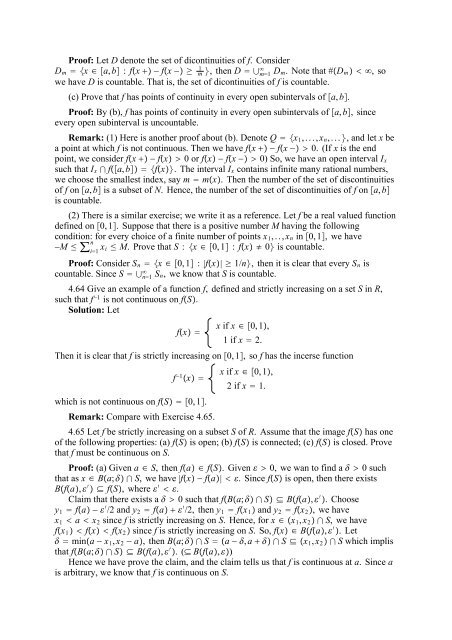The Real And Complex Number Systems
The Real And Complex Number Systems
The Real And Complex Number Systems
Create successful ePaper yourself
Turn your PDF publications into a flip-book with our unique Google optimized e-Paper software.
Proof: Let D denote the set of dicontinuities of f. Consider<br />
D m x a, b : fx fx m 1 , then D <br />
m1 D m . Note that #D m , so<br />
we have D is countable. That is, the set of dicontinuities of f is countable.<br />
(c) Prove that f has points of continuity in every open subintervals of a, b.<br />
Proof: By (b), f has points of continuity in every open subintervals of a, b, since<br />
every open subinterval is uncountable.<br />
Remark: (1) Here is another proof about (b). Denote Q x 1 ,...,x n ,..., and let x be<br />
a point at which f is not continuous. <strong>The</strong>n we have fx fx 0. (If x is the end<br />
point, we consider fx fx 0orfx fx 0) So, we have an open interval I x<br />
such that I x fa, b fx. <strong>The</strong> interval I x contains infinite many rational numbers,<br />
we choose the smallest index, say m mx. <strong>The</strong>n the number of the set of discontinuities<br />
of f on a, b is a subset of N. Hence, the number of the set of discontinuities of f on a, b<br />
is countable.<br />
(2) <strong>The</strong>re is a similar exercise; we write it as a reference. Let f be a real valued function<br />
defined on 0, 1. Suppose that there is a positive number M having the following<br />
condition: for every choice of a finite number of points x 1 ,..,x n in 0, 1, wehave<br />
n<br />
M i1<br />
x i M. Prove that S : x 0, 1 : fx 0 is countable.<br />
Proof: Consider S n x 0, 1 : |fx| 1/n, then it is clear that every S n is<br />
countable. Since S <br />
n1 S n , we know that S is countable.<br />
4.64 Give an example of a function f, defined and strictly increasing on a set S in R,<br />
such that f 1 is not continuous on fS.<br />
Solution: Let<br />
x if x 0, 1,<br />
fx <br />
1ifx 2.<br />
<strong>The</strong>n it is clear that f is strictly increasing on 0, 1, sof has the incerse function<br />
x if x 0, 1,<br />
f 1 x <br />
2ifx 1.<br />
which is not continuous on fS 0, 1.<br />
Remark: Compare with Exercise 4.65.<br />
4.65 Let f be strictly increasing on a subset S of R. Assume that the image fS has one<br />
of the following properties: (a) fS is open; (b) fS is connected; (c) fS is closed. Prove<br />
that f must be continuous on S.<br />
Proof: (a) Given a S, then fa fS. Given 0, wewantofinda 0 such<br />
that as x Ba; S, wehave|fx fa| . SincefS is open, then there exists<br />
Bfa, fS, where .<br />
Claim that there exists a 0 such that fBa; S Bfa, . Choose<br />
y 1 fa /2 and y 2 fa /2, then y 1 fx 1 and y 2 fx 2 ,wehave<br />
x 1 a x 2 since f is strictly increasing on S. Hence, for x x 1 , x 2 S, wehave<br />
fx 1 fx fx 2 since f is strictly increasing on S. So,fx Bfa, .Let<br />
mina x 1 , x 2 a, then Ba; S a , a S x 1 , x 2 S which implis<br />
that fBa; S Bfa, .( Bfa, )<br />
Hence we have prove the claim, and the claim tells us that f is continuous at a. Sincea<br />
is arbitrary, we know that f is continuous on S.
















